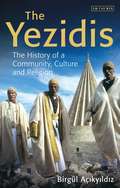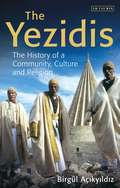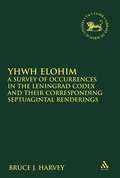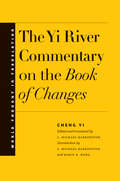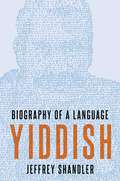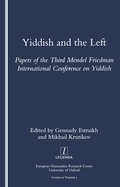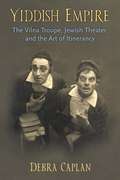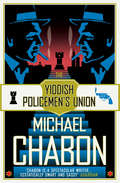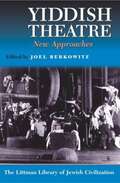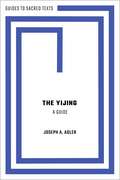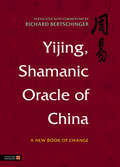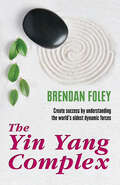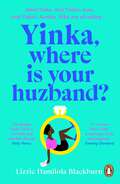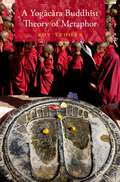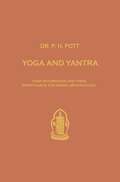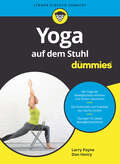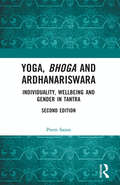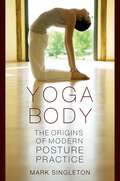- Table View
- List View
The Yezidis: The History of a Community, Culture and Religion
by Birgül AçikyildizYezidism is a fascinating part of the rich cultural mosaic of the Middle East. The Yezidi faith emerged for the first time in the twelfth century in the Kurdish mountains of northern Iraq. The religion, which has become notorious for its associations with 'devil worship', is in fact an intricate syncretic system of belief, incorporating elements from proto-Indo-European religions, early Iranian faiths like Zoroastrianism and Manichaeism, Sufism and regional paganism like Mithraism. Birgul Acikyildiz here offers a comprehensive appraisal of Yezidi religion, society and culture. Written without presupposing any prior knowledge about Yezidism, and in an accessible and readable style, her book examines Yezidis not only from a religious point of view but as a historical and social phenomenon. She throws light on the origins of Yezidism, and charts its development and changing fortunes - from its beginnings to the present- as part of the general history of the Kurds. Her book is the first to place Yezidism in its complete geographical setting in Northern Iraq, Turkey, Syria and Transcaucasia.The author describes the Yezidi belief system (which considers Tawusi Melek - the 'Peacock Angel' - to be ruler of the earth) and its religious practices and observances, analysing the most important facets of Yezidi religious art and architecture (including funerary monuments and zoomorphic tombstones) and their relationship to their neighbours throughout the Middle East. Acikyildiz also explores the often misunderstood connections between Yezidism and the Satan/Sheitan of Christian and Muslim tradition. Richly illustrated, with accompanying maps, photographs and illustrations, this pioneering book will have strong appeal to all those with an interest in the culture of the Kurds, as well as the wider region.
The Yezidis: The History of a Community, Culture and Religion (Library of Modern Religion)
by Birgül AçikyildizYezidism is a fascinating part of the rich cultural mosaic of the Middle East. The Yezidi faith emerged for the first time in the twelfth century in the Kurdish mountains of northern Iraq. The religion, which has become notorious for its associations with 'devil worship', is in fact an intricate syncretic system of belief, incorporating elements from proto-Indo-European religions, early Iranian faiths like Zoroastrianism and Manichaeism, Sufism and regional paganism like Mithraism. Birgül Açikyildiz here offers a comprehensive appraisal of Yezidi religion, society and culture.Written without presupposing any prior knowledge about Yezidism, and in an accessible and readable style, her book examines Yezidis not only from a religious point of view but as a historical and social phenomenon. She throws light on the origins of Yezidism, and charts its development and changing fortunes - from its beginnings to the present- as part of the general history of the Kurds. Her book is the first to place Yezidism in its complete geographical setting in Northern Iraq, Turkey, Syria and Transcaucasia. The author describes the Yezidi belief system (which considers Tawûsî Melek - the 'Peacock Angel' - to be ruler of the earth) and its religious practices and observances, analysing the most important facets of Yezidi religious art and architecture (including funerary monuments and zoomorphic tombstones) and their relationship to their neighbours throughout the Middle East. Açikyildiz also explores the often misunderstood connections between Yezidism and the Satan/Sheitan of Christian and Muslim tradition.Richly illustrated, with accompanying maps, photographs and illustrations, this pioneering book will have strong appeal to all those with an interest in the culture of the Kurds, as well as the wider region.
YHWH Elohim: A Survey of Occurrences in the Leningrad Codex and their Corresponding Septuagintal Renderings (The Library of Hebrew Bible/Old Testament Studies)
by Bruce J. HarveyThis study provides a survey of all occurrences of YHWH that are followed by an Elohim appositive in the Leningrad Codex and their corresponding Septuagintal renderings. Its primary purpose is to demonstrate how each occurrence of YHWH Elohim, where Elohim is undetermined, could have resulted from changes made to an earlier text. It begins with a discussion of methodological issues. This is followed by a description of the Hebrew context of the 887 occurrences of YHWH Elohim in the Leningrad Codex. In addition to breakdowns according to book, syntactic function and speaker, a summary of corresponding variants in synoptic parallels, the Samaritan Pentateuch, Dead Sea Scrolls and mediaeval manuscripts is also provided. This is followed by a summary of corresponding Septuagintal renderings. These context descriptions provide the foundation for an analysis of the 38 occurrences of YHWH Elohim where Elohim is undetermined. Since four of these occurrences are followed by Sabaoth, a survey of all compound designations containing Sabaoth as well as an analysis of the 18 occurrences of YHWH Elohe Sabaoth are also provided.
The Yi River Commentary on the Book of Changes (World Thought in Translation)
by Cheng YiA translation of a key commentary on perhaps the most broadly influential text of classical China This book is a translation of a key commentary on the Book of Changes, or Yijing (I Ching), perhaps the most broadly influential text of classical China. The Yijing first appeared as a divination text in Zhou-dynasty China (ca. 1045–256 bce) and later became a work of cosmology, philosophy, and political theory as commentators supplied it with new meanings. While many English translations of the Yijing itself exist, none are paired with a historical commentary as thorough and methodical as that written by the Confucian scholar Cheng Yi, who turned the original text into a coherent work of political theory.
Yiddish: Biography of a Language
by Jeffrey ShandlerThe most widely spoken Jewish language on the eve of the Holocaust, Yiddish continues to play a significant role in Jewish life today, from Hasidim for whom it is a language of daily life to avant-garde performers, political activists, and LGBTQ writers turning to Yiddish for inspiration. Yiddish: Biography of a Language presents the story of this centuries-old language, the defining vernacular of Ashkenazi Jews, from its origins to the present. Jeffrey Shandler tells the multifaceted history of Yiddish in the form of a biographical profile, revealing surprising insights through a series of thematic chapters. He addresses key aspects of Yiddish as the language of a diasporic population, whose speakers have always used more than one language. As the vernacular of a marginalized minority, Yiddish has often been held in low regard compared to other languages, and its legitimacy as a language has been questioned. But some devoted Yiddish speakers have championed the language as embodying the essence of Jewish culture and a defining feature of a Jewish national identity. Despite predictions of the demise of Yiddish-dating back well before half of its speakers were murdered during the Holocaust-the language leads a vibrant, evolving life to this day.
Yiddish: Biography of a Language
by Jeffrey ShandlerThe most widely spoken Jewish language on the eve of the Holocaust, Yiddish continues to play a significant role in Jewish life today, from Hasidim for whom it is a language of daily life to avant-garde performers, political activists, and LGBTQ writers turning to Yiddish for inspiration. Yiddish: Biography of a Language presents the story of this centuries-old language, the defining vernacular of Ashkenazi Jews, from its origins to the present. Jeffrey Shandler tells the multifaceted history of Yiddish in the form of a biographical profile, revealing surprising insights through a series of thematic chapters. He addresses key aspects of Yiddish as the language of a diasporic population, whose speakers have always used more than one language. As the vernacular of a marginalized minority, Yiddish has often been held in low regard compared to other languages, and its legitimacy as a language has been questioned. But some devoted Yiddish speakers have championed the language as embodying the essence of Jewish culture and a defining feature of a Jewish national identity. Despite predictions of the demise of Yiddish-dating back well before half of its speakers were murdered during the Holocaust-the language leads a vibrant, evolving life to this day.
Yiddish and the Left: Papers of the Third Mendel Friedman International Conference on Yiddish
by Gennady Estraikh"For over a century Yiddish served as a major vehicle for expressing left-wing ideas and sensitivities. A language without country, an ""ugly jargon"" despised by assimilationist Jewish bourgeoisie and nationalist Zionists alike, it was embraced as genuine folk idiom by Jewish adherents of socialism and communism worldwide. Following the Holocaust, Yiddish was the primary language of education, culture and propaganda for millions of people on five continents. This volume examines the diversity of relationships between Yiddish and the Left, from the attitude of Yiddish writers to apartheid in South Africa to the vicissitudes of the Yiddish communist press in the Soviet Union and the USA."
Yiddish and the Left: Papers of the Third Mendel Friedman International Conference on Yiddish
by Gennady Estraikh"For over a century Yiddish served as a major vehicle for expressing left-wing ideas and sensitivities. A language without country, an ""ugly jargon"" despised by assimilationist Jewish bourgeoisie and nationalist Zionists alike, it was embraced as genuine folk idiom by Jewish adherents of socialism and communism worldwide. Following the Holocaust, Yiddish was the primary language of education, culture and propaganda for millions of people on five continents. This volume examines the diversity of relationships between Yiddish and the Left, from the attitude of Yiddish writers to apartheid in South Africa to the vicissitudes of the Yiddish communist press in the Soviet Union and the USA."
Yiddish Empire: The Vilna Troupe, Jewish Theater, and the Art of Itinerancy
by Debra CaplanYiddish Empire tells the story of how a group of itinerant Jewish performers became the interwar equivalent of a viral sensation, providing a missing chapter in the history of the modern stage. During World War I, a motley group of teenaged amateurs, impoverished war refugees, and out- of- work Russian actors banded together to revolutionize the Yiddish stage. Achieving a most unlikely success through their productions, the Vilna Troupe (1915– 36) would eventually go on to earn the attention of theatergoers around the world. Advancements in modern transportation allowed Yiddish theater artists to reach global audiences, traversing not only cities and districts but also countries and continents. The Vilna Troupe routinely performed in major venues that had never before allowed Jews, let alone Yiddish, upon their stages, and operated across a vast territory, a strategy that enabled them to attract unusually diverse audiences to the Yiddish stage and a precursor to the organizational structures and travel patterns that we see now in contemporary theater. Debra Caplan’s history of the Troupe is rigorously researched, employing primary and secondary sources in multiple languages, and is engagingly written.
The Yiddish Policemen’s Union: A Novel (P. S. Ser.)
by Michael ChabonSet in the Jewish homeland of … Alaska, this is a brilliantly original novel from Michael Chabon, author of THE ADVENTURES OF KAVALIER & CLAY and WONDER BOYS.
Yiddish Theatre: New Approaches (The Littman Library of Jewish Civilization)
by Joel BerkowitzThis volume of essays is the first collection of scholarly studies on the Yiddish theatre to appear in English. Drawing on a variety of academic disciplines, it considers the dramatic and musical repertoire of Yiddish theatre and their historical development, popular and critical reception of productions, and the practice and consequences of state censorship. The time-span covered is broad—from the Middle Ages to the twentieth century—as is the geographical range: Cracow, London, Moscow, New York, St Petersburg, Vienna, and Warsaw. Yiddish Theatre not only presents a comprehensive study of the field but also helps illustrate the significance of the Yiddish theatre as a vital form of expression in the Jewish world. Yiddish drama and theatre has had an enormous capacity to entertain audiences on six continents, while at the same time highlighting social, political, religious, and economic concerns of vital interest to the Jewish people. Yiddish Theatre is a valuable resource for scholars, university students, and general readers interested both in Yiddish theatre specifically and related fields such as Jewish literature and culture, east European history and culture, and European and American theatre. The book contains the most comprehensive bibliography to date of sources relating to the Yiddish theatre.CONTRIBUTORS: Ahuva Belkin, Joel Berkowitz Paola Bertolone, Miroslawa M. Bulat, Brigitte Dalinger, Barbara Henry, John Klier, David Mazower, Leonard Prager, Nahma Sandrow, Nina Warnke, Seth L. Wolitz.
The Yijing: A Guide (Guides to Sacred Texts)
by Joseph A. AdlerDespite its enduring popularity both in China and worldwide, the Yijing is often poorly understood. As a divinatory text, it has a devoted following in the western hemisphere, even as it represents a foundational text of both Confucianism and Daoism. A fascination with the Yijing has been evident among western scholars since the Enlightenment, as well as in notable modern literary and artistic figures. This book provides an introduction for the general reader to this classic sacred text. Joseph A. Adler explains its multi-layered structure, its origins, its history of interpretation from the early first millennium BCE up to the present day, its function of divination, its significance in the history of Chinese thought, and its modern transformations. He explores why the Yijing has been considered the most profound expression of traditional Chinese thought and what meaning it can have for contemporary readers.
The Yijing: A Guide (Guides to Sacred Texts)
by Joseph A. AdlerDespite its enduring popularity both in China and worldwide, the Yijing is often poorly understood. As a divinatory text, it has a devoted following in the western hemisphere, even as it represents a foundational text of both Confucianism and Daoism. A fascination with the Yijing has been evident among western scholars since the Enlightenment, as well as in notable modern literary and artistic figures. This book provides an introduction for the general reader to this classic sacred text. Joseph A. Adler explains its multi-layered structure, its origins, its history of interpretation from the early first millennium BCE up to the present day, its function of divination, its significance in the history of Chinese thought, and its modern transformations. He explores why the Yijing has been considered the most profound expression of traditional Chinese thought and what meaning it can have for contemporary readers.
Yijing, Shamanic Oracle of China: A New Book of Change
by Richard BertschingerFor the Chinese, the destiny of each individual and the cosmos have always been inextricably linked, and for two thousand years the Yijing, or the Book of Change, has exercised the best minds in the Orient. Richard Bertschinger, author of The Secret of Everlasting Life (the first translation of The Can Tong Qi), has worked from the classical commentaries to make a fresh and up-to-date translation for the modern world. Marriage, business ventures, journeys, military ventures, disputes, world affairs, personal problems, health or money issues, all are grist for the mill of the Book of Change. Through pondering the lines, studying their poetry, and devoting ourselves to its meaning, the heart of the ancients is clear. We pick up perhaps in a way we never could have conceived of, how to guide and direct our lives. With an introduction that explains the underlying structure and philosophy of the Book of Change, as well as its history, and a detailed explanation of how to throw the yarrow sticks, or the coins, the novice reader is given everything they need to take their first steps in consulting the ancient oracle, and those already familiar with established translations will find this fresh translation from the original texts clear and illuminating.
Yijing, Shamanic Oracle of China: A New Book of Change (PDF)
by Richard BertschingerFor the Chinese, the destiny of each individual and the cosmos have always been inextricably linked, and for two thousand years the Yijing, or the Book of Change, has exercised the best minds in the Orient. Richard Bertschinger, author of The Secret of Everlasting Life (the first translation of The Can Tong Qi), has worked from the classical commentaries to make a fresh and up-to-date translation for the modern world. Marriage, business ventures, journeys, military ventures, disputes, world affairs, personal problems, health or money issues, all are grist for the mill of the Book of Change. Through pondering the lines, studying their poetry, and devoting ourselves to its meaning, the heart of the ancients is clear. We pick up perhaps in a way we never could have conceived of, how to guide and direct our lives. With an introduction that explains the underlying structure and philosophy of the Book of Change, as well as its history, and a detailed explanation of how to throw the yarrow sticks, or the coins, the novice reader is given everything they need to take their first steps in consulting the ancient oracle, and those already familiar with established translations will find this fresh translation from the original texts clear and illuminating.
The Yin Yang Complex: Create success by understanding one of the world’s oldest dynamic forces
by Brendan FoleyIn The Yin Yang Complex you will be taken on a journey of discovery that will unearth the reason why the world is in its current state and why you have evolved in the manner that you have. From the Mesolithic period to the modern day, we explore how we have become so unbalanced. He takes ancient knowledge and applies it to our lives today, our businesses, the environment and we see what we can learn. Each chapter has exercises associated with it that will allow you to personally explore your own balance and that in your life. You will learn the keys to great relationships, successful business and all other aspects of your life. This book will give you a comprehensive understanding of the masculine and feminine energies.
Yinka, Where is Your Huzband?: The hilarious and heartfelt romcom everyone is talking about in 2022
by Lizzie Damilola Blackburn'Hilarious, insightful and so uplifting' Beth O'Leary 'Such a warm, funny and relatable book' Jendella Benson -------------------------Yinka wants to find love. Her mum wants to find it for her. She also has too many aunties who frequently pray for her delivery from singledom, a preference for chicken and chips over traditional Nigerian food, and a bum she's sure is far too small as a result. Oh, and the fact that she's a thirty-one-year-old South-Londoner who doesn't believe in sex before marriage is a bit of an obstacle too... When her cousin gets engaged, Yinka commences 'Operation Find A Date for Rachel's Wedding'. Armed with a totally flawless, incredibly specific plan, will Yinka find herself a huzband? What if the thing she really needs to find is herself? MARIE CLAIRE 'BEST BOOKS OF 2022' AND FEBRUARY PICK FOR MALALA'S LITERATI BOOKCLUB-------------------------Your favourite authors have all fallen in love with Yinka'The spiritual heir to Bridget Jones's Diary, while bringing something entirely fresh and modern to the table' Emily Henry, You and Me on Vacation'Warm and fun and sweet' Marian Keyes, Again, Rachel'Glorious debut! Read it over two nights and loved it!' Nikki May, Wahala 'Beautifully observed, warm and deeply human, Yinka is a meditation on family and friendship, on love and self-love' Josie Silver, One Night on the Island 'A joyful, pacy romp. Yinka's world is both hilarious and poignant' Irenosen Okojie MBE, Butterfly Fish 'A story about friendship, family, romance, and the most important quest of all - loving and accepting yourself' Lauren Ho, Last Tang Standing 'A beautiful, big hearted story about friendship, family, and love' Emiko Jean, Tokyo Ever After 'Yinka is the most loveable character you'll meet' Lolá Ákínmádé Åkerström, In Every Mirror She's Black 'Funny, charming, warm. A book that will make your heart smile' Milly Johnson, My One True North 'A gorgeous, easy read, but with real depth to its punchy chapters. Extraordinary' Lizzy Dent, The Summer JobAnd everyone else loves her too'Peckham's Bridget Jones' Evening Standard'Incredibly relatable' Marie Claire, Best Books of 2022'A fresh take on culture clashes, female friendship and the stigma about being single' Heat Magazine'A clever twist on the romcom archetype' Daily Mail'Fabulously fun' Prima'One of the talked-about debut novels' - The Sunday Times'More than a book about a woman looking for a man. It addresses female friendships, black beauty standards and religion' Mail on Sunday
A Yog=ac=ara Buddhist Theory of Metaphor
by Roy TzoharBuddhist philosophy is fundamentally ambivalent toward language. Language is paradoxically seen as both obstructive and necessary for liberation. In this book, Roy Tzohar delves into the ingenious response to this tension from the Yogacara school of Indian Buddhism: that all language-use is metaphorical. Exploring the profound implications of this claim, Tzohar makes the case for viewing the Yogacara account as a full-fledged theory of meaning, one that is not merely linguistic, but also applicable both in the world as well as in texts. Despite the overwhelming visibility of figurative language in Buddhist philosophical texts, this is the first sustained and systematic attempt to present an indigenous Buddhist theory of metaphor. By grounding the Yogacara pan-metaphorical claim in a broader intellectual context, of both Buddhist and non-Buddhist schools, the book uncovers an intense philosophical conversation about metaphor and language that reaches across sectarian lines. Tzohar's analysis radically reframes the Yogacara controversy with the Madhyamaka school of philosophy, sheds light on the Yogacara application of particular metaphors, and explicates the school's unique understanding of experience.
A Yog=ac=ara Buddhist Theory of Metaphor
by Roy TzoharBuddhist philosophy is fundamentally ambivalent toward language. Language is paradoxically seen as both obstructive and necessary for liberation. In this book, Roy Tzohar delves into the ingenious response to this tension from the Yogacara school of Indian Buddhism: that all language-use is metaphorical. Exploring the profound implications of this claim, Tzohar makes the case for viewing the Yogacara account as a full-fledged theory of meaning, one that is not merely linguistic, but also applicable both in the world as well as in texts. Despite the overwhelming visibility of figurative language in Buddhist philosophical texts, this is the first sustained and systematic attempt to present an indigenous Buddhist theory of metaphor. By grounding the Yogacara pan-metaphorical claim in a broader intellectual context, of both Buddhist and non-Buddhist schools, the book uncovers an intense philosophical conversation about metaphor and language that reaches across sectarian lines. Tzohar's analysis radically reframes the Yogacara controversy with the Madhyamaka school of philosophy, sheds light on the Yogacara application of particular metaphors, and explicates the school's unique understanding of experience.
Yoga and Yantra: Their Interrelation and Their Significance for Indian Archaeology (Verhandelingen van het Koninklijk Instituut voor Taal-, Land- en Volkenkunde)
by Philipp H. PottYoga auf dem Stuhl für Dummies (Für Dummies)
by Larry Payne Don HenryAlles, was Sie für Yoga brauchen, ist ein Stuhl. Larry Payne und Don Henry zeigen Ihnen in diesem Buch, wie Sie dank der Stabilität und Sicherheit, die Ihnen ein Stuhl bietet, Yoga praktizieren können - auch, wenn Sie in Ihrer Mobilität eingeschränkt sind. Das Buch enthält viele Illustrationen und Beschreibungen traditioneller Yoga-Übungen, die Sie auch im Sitzen ausführen können. So kann jeder von der entspannenden und stresslindernden Wirkung von Yoga profitieren, sei es nach einer Verletzung, im fortgeschrittenen Alter, in der Schwangerschaft und vieles mehr. Stellen Sie mit diesem Buch Ihren eigenen Übungsplan für zu Hause, unterwegs oder im Büro zusammen. So bleiben Sie auch im Sitzen aktiv!
Yoga, Bhoga and Ardhanariswara: Individuality, Wellbeing and Gender in Tantra
by Prem SaranThis book offers a social–scientific interpretation of the Hindu and Buddhist traditions of Tantra dating back 15 centuries. It is a self-reflexive study approached with an insider’s empathy and the perspective of an Indologist, anthropologist, mystic and practitioner of the cult. The work includes a discussion of non-modern Indic themes: mandala as a trope and its manifestations in South Asian regions such as Nepal; yoga and Indic individuality; the concept of bhoga; disciplined wellbeing; gender; and Indic axiology. Using personal praxis to inform his research, the author examines three core themes within Tantra — a ‘holonic’/mandalic individuality that conduces to mystical experience; a positive valorisation of pleasure and play; and cultural attitudes of gender-mutuality and complementarity, as neatly encapsulated in the icon of Shiva as Ardhanariswara. This analysis, as captured by the Tantric mandalas of deities in intimate union, leads to his compelling metathesis that Tantra serves as a permanent counterculture within the Indic civilization. This second edition, with a new Afterword, will greatly interest those in anthropology, South Asian studies, religious studies, gender studies, psychology and philosophy, as also the general reader.
Yoga, Bhoga and Ardhanariswara: Individuality, Wellbeing and Gender in Tantra
by Prem SaranThis book offers a social–scientific interpretation of the Hindu and Buddhist traditions of Tantra dating back 15 centuries. It is a self-reflexive study approached with an insider’s empathy and the perspective of an Indologist, anthropologist, mystic and practitioner of the cult. The work includes a discussion of non-modern Indic themes: mandala as a trope and its manifestations in South Asian regions such as Nepal; yoga and Indic individuality; the concept of bhoga; disciplined wellbeing; gender; and Indic axiology. Using personal praxis to inform his research, the author examines three core themes within Tantra — a ‘holonic’/mandalic individuality that conduces to mystical experience; a positive valorisation of pleasure and play; and cultural attitudes of gender-mutuality and complementarity, as neatly encapsulated in the icon of Shiva as Ardhanariswara. This analysis, as captured by the Tantric mandalas of deities in intimate union, leads to his compelling metathesis that Tantra serves as a permanent counterculture within the Indic civilization. This second edition, with a new Afterword, will greatly interest those in anthropology, South Asian studies, religious studies, gender studies, psychology and philosophy, as also the general reader.
Yoga Body: The Origins of Modern Posture Practice
by Mark SingletonYoga is so prevalent in the modern world--practiced by pop stars, taught in schools, and offered in yoga centers, health clubs, and even shopping malls--that we take its presence, and its meaning, for granted. But how did the current yoga boom happen? And is it really rooted in ancient Indian practices, as many of its adherents claim? In this groundbreaking book, Mark Singleton calls into question many commonly held beliefs about the nature and origins of postural yoga (asana) and suggests a radically new way of understanding the meaning of yoga as it is practiced by millions of people across the world today. Singleton shows that, contrary to popular belief, there is no evidence in the Indian tradition for the kind of health and fitness-oriented asana practice that dominates the global yoga scene of the twenty-first century. Singleton's surprising--and surely controversial--thesis is that yoga as it is popularly practiced today owes a greater debt to modern Indian nationalism and, even more surprisingly, to the spiritual aspirations of European bodybuilding and early 20th-century women's gymnastic movements of Europe and America, than it does to any ancient Indian yoga tradition. This discovery enables Singleton to explain, as no one has done before, how the most prevalent forms of postural yoga, like Ashtanga, Bikram and "Hatha" yoga, came to be the hugely popular phenomena they are today. Drawing on a wealth of rare documents from archives in India, the UK and the USA, as well as interviews with the few remaining, now very elderly figures in the 1930s Mysore asana revival, Yoga Body turns the conventional wisdom about yoga on its head.
Yoga Body: The Origins of Modern Posture Practice
by Mark SingletonYoga is so prevalent in the modern world--practiced by pop stars, taught in schools, and offered in yoga centers, health clubs, and even shopping malls--that we take its presence, and its meaning, for granted. But how did the current yoga boom happen? And is it really rooted in ancient Indian practices, as many of its adherents claim? In this groundbreaking book, Mark Singleton calls into question many commonly held beliefs about the nature and origins of postural yoga (asana) and suggests a radically new way of understanding the meaning of yoga as it is practiced by millions of people across the world today. Singleton shows that, contrary to popular belief, there is no evidence in the Indian tradition for the kind of health and fitness-oriented asana practice that dominates the global yoga scene of the twenty-first century. Singleton's surprising--and surely controversial--thesis is that yoga as it is popularly practiced today owes a greater debt to modern Indian nationalism and, even more surprisingly, to the spiritual aspirations of European bodybuilding and early 20th-century women's gymnastic movements of Europe and America, than it does to any ancient Indian yoga tradition. This discovery enables Singleton to explain, as no one has done before, how the most prevalent forms of postural yoga, like Ashtanga, Bikram and "Hatha" yoga, came to be the hugely popular phenomena they are today. Drawing on a wealth of rare documents from archives in India, the UK and the USA, as well as interviews with the few remaining, now very elderly figures in the 1930s Mysore asana revival, Yoga Body turns the conventional wisdom about yoga on its head.
